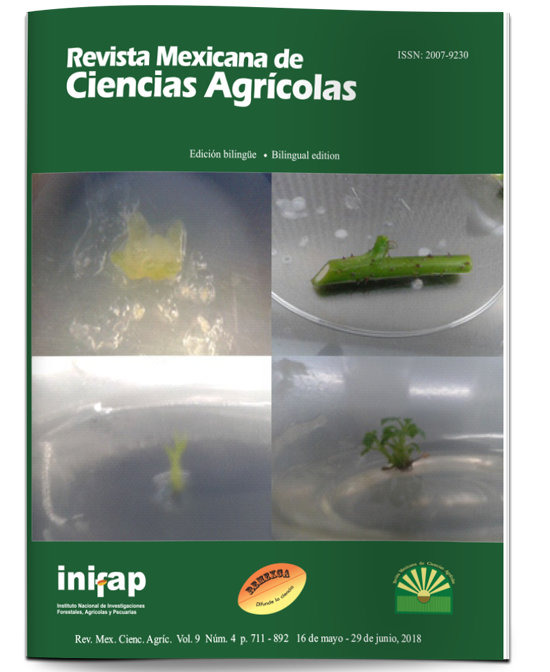In vitro evaluation of the antifungal activity of Heliopsis longipes extract in strains of Sclerotium cepivorum and Sclerotinia sclerotiorum
DOI:
https://doi.org/10.29312/remexca.v9i4.337Keywords:
Heliopsis longipes, Sclerotium cepivorum, Sclerotinia sclerotiorum, viability of sclerotiaAbstract
White rot and soft rot caused by Sclerotium cepivorum and Sclerotinia sclerotiorum are the main cause of losses in garlic and lettuce crops, making their control difficult due to the production of sclerotia. An environmentally friendly alternative to disease control is the use of plant extracts; like Heliopsis longipes, which has the capacity to produce alcamidas like afinina, which are responsible for its effect as an insecticide and bactericide, it is worth mentioning that this compound is found in greater proportion in the roots of the plant. Therefore, the biological material was collected in Guanajuato in 2013, from which the fungus was isolated and in which the antifungal activity of the extract was evaluated and the viability of the sclerotia of Sclerotium cepivorum and Sclerotinia sclerotiorum was verified. through the technique of poisoned medium. Obtaining percentages of inhibition higher than 75% for the strains of Sclerotium cepivorum, while for Sclerotinia sclerotiorum less than 40%. In addition to showing statistically significant reduction in the production of sclerotia and only affect the vigor of growth in one of the strains evaluated. Therefore, the extract showed to be effective in the control of the parameters evaluated.
Downloads
Downloads
Published
How to Cite
Issue
Section
License
The authors who publish in Revista Mexicana de Ciencias Agrícolas accept the following conditions:
In accordance with copyright laws, Revista Mexicana de Ciencias Agrícolas recognizes and respects the authors’ moral right and ownership of property rights which will be transferred to the journal for dissemination in open access. Invariably, all the authors have to sign a letter of transfer of property rights and of originality of the article to Instituto Nacional de Investigaciones Forestales, Agrícolas y Pecuarias (INIFAP) [National Institute of Forestry, Agricultural and Livestock Research]. The author(s) must pay a fee for the reception of articles before proceeding to editorial review.
All the texts published by Revista Mexicana de Ciencias Agrícolas —with no exception— are distributed under a Creative Commons License Attribution-NonCommercial 4.0 International (CC BY-NC 4.0), which allows third parties to use the publication as long as the work’s authorship and its first publication in this journal are mentioned.
The author(s) can enter into independent and additional contractual agreements for the nonexclusive distribution of the version of the article published in Revista Mexicana de Ciencias Agrícolas (for example include it into an institutional repository or publish it in a book) as long as it is clearly and explicitly indicated that the work was published for the first time in Revista Mexicana de Ciencias Agrícolas.
For all the above, the authors shall send the Letter-transfer of Property Rights for the first publication duly filled in and signed by the author(s). This form must be sent as a PDF file to: revista_atm@yahoo.com.mx; cienciasagricola@inifap.gob.mx; remexca2017@gmail.
This work is licensed under a Creative Commons Attribution-Noncommercial 4.0 International license.



